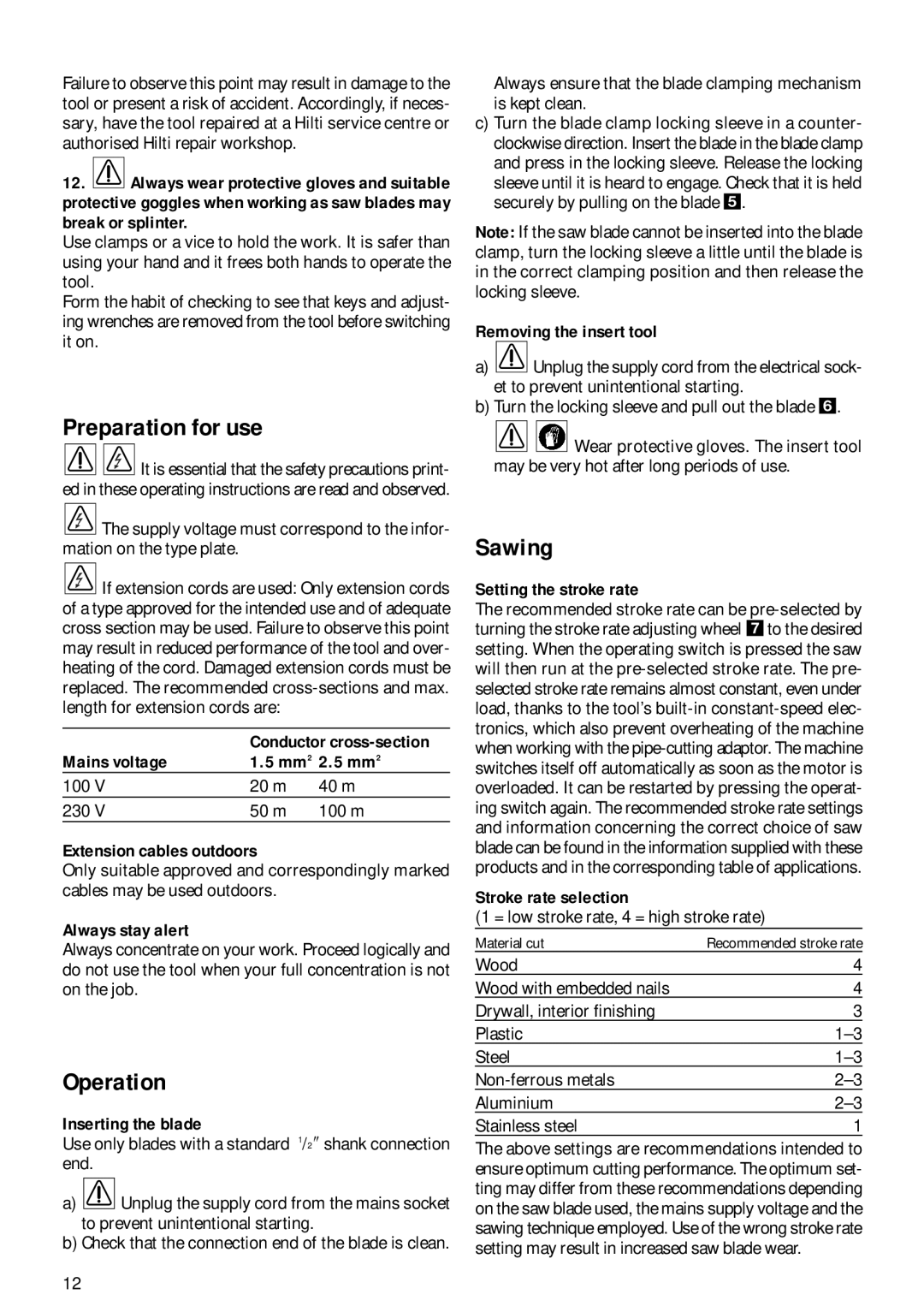
Failure to observe this point may result in damage to the tool or present a risk of accident. Accordingly, if neces- sary, have the tool repaired at a Hilti service centre or authorised Hilti repair workshop.
12.![]() Always wear protective gloves and suitable protective goggles when working as saw blades may break or splinter.
Always wear protective gloves and suitable protective goggles when working as saw blades may break or splinter.
Use clamps or a vice to hold the work. It is safer than using your hand and it frees both hands to operate the tool.
Form the habit of checking to see that keys and adjust- ing wrenches are removed from the tool before switching it on.
Preparation for use
![]()
![]() It is essential that the safety precautions print- ed in these operating instructions are read and observed.
It is essential that the safety precautions print- ed in these operating instructions are read and observed.
![]()
![]()
![]() The supply voltage must correspond to the infor- mation on the type plate.
The supply voltage must correspond to the infor- mation on the type plate.
![]() If extension cords are used: Only extension cords of a type approved for the intended use and of adequate cross section may be used. Failure to observe this point may result in reduced performance of the tool and over- heating of the cord. Damaged extension cords must be replaced. The recommended
If extension cords are used: Only extension cords of a type approved for the intended use and of adequate cross section may be used. Failure to observe this point may result in reduced performance of the tool and over- heating of the cord. Damaged extension cords must be replaced. The recommended
| Conductor | |
Mains voltage | 1.5 mm2 | 2.5 mm2 |
100 V | 20 m | 40 m |
230 V | 50 m | 100 m |
Extension cables outdoors
Only suitable approved and correspondingly marked cables may be used outdoors.
Always stay alert
Always concentrate on your work. Proceed logically and do not use the tool when your full concentration is not on the job.
Operation
Inserting the blade
Use only blades with a standard 1/2″ shank connection end.
a)![]() Unplug the supply cord from the mains socket to prevent unintentional starting.
Unplug the supply cord from the mains socket to prevent unintentional starting.
b)Check that the connection end of the blade is clean.
Always ensure that the blade clamping mechanism is kept clean.
c)Turn the blade clamp locking sleeve in a counter- clockwise direction. Insert the blade in the blade clamp
and press in the locking sleeve. Release the locking sleeve until it is heard to engage. Check that it is held securely by pulling on the blade .
Note: If the saw blade cannot be inserted into the blade clamp, turn the locking sleeve a little until the blade is in the correct clamping position and then release the locking sleeve.
Removing the insert tool
a)![]() Unplug the supply cord from the electrical sock- et to prevent unintentional starting.
Unplug the supply cord from the electrical sock- et to prevent unintentional starting.
b) Turn the locking sleeve and pull out the blade .
![]()
![]() Wear protective gloves. The insert tool may be very hot after long periods of use.
Wear protective gloves. The insert tool may be very hot after long periods of use.
Sawing
Setting the stroke rate
The recommended stroke rate can be
Stroke rate selection
(1 = low stroke rate, 4 = high stroke rate)
Material cut | Recommended stroke rate |
Wood | 4 |
Wood with embedded nails | 4 |
Drywall, interior finishing | 3 |
Plastic | |
Steel | |
Aluminium | |
Stainless steel | 1 |
The above settings are recommendations intended to ensure optimum cutting performance. The optimum set- ting may differ from these recommendations depending on the saw blade used, the mains supply voltage and the sawing technique employed. Use of the wrong stroke rate setting may result in increased saw blade wear.
12
